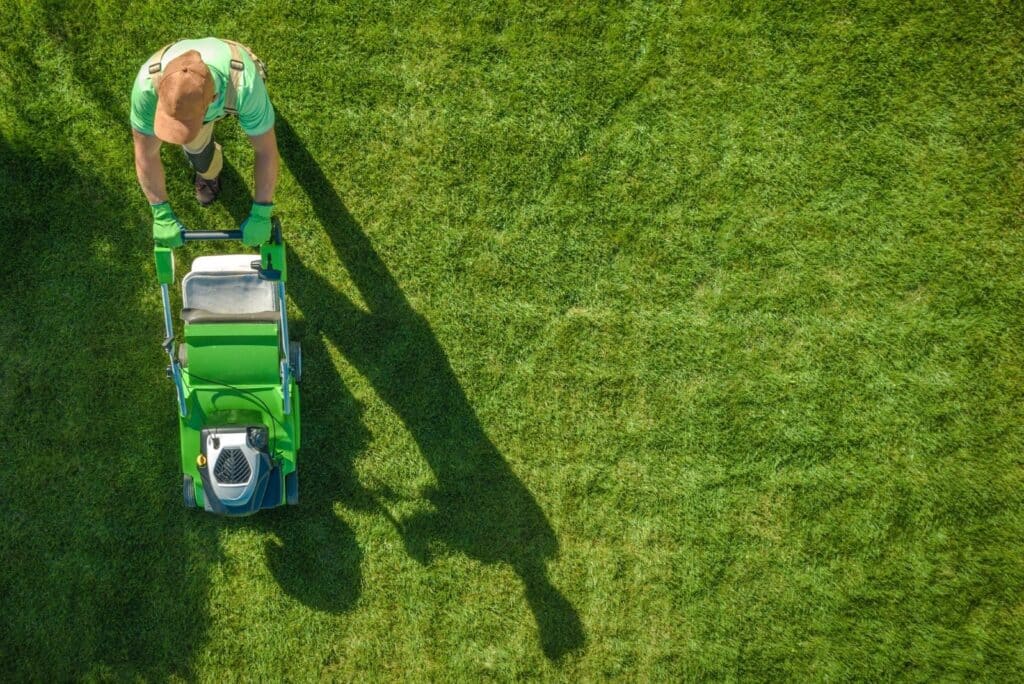
Mowing your lawn is an essential part of achieving a neat and healthy lawn.
Have you ever noticed the difference in appearance between two neighbouring lawns in the same street? In addition to the frequency of mowing, many parameters come into play in this art aimed at obtaining a beautiful green carpet. Here you will discover all the secrets that forge the gardener’s talent when it comes to lawn mowing!
Why mow your lawn?
Mowing has several goals:
– get an nice aesthetic and regular style;
– strengthen the grasses, producing more vigorous leaves;
– ensure the development of the roots to obtain more density and a beautiful consistency of the lawn;
– facilitate movement if the lawn is made up of a mixture of grasses that tolerate being walked on, especially on walkways.

Which tool to choose?
Depending on the surface, the slope, but also the time the gardener can devote to his lawn, the choice will be made on various options:
Classic lawn mowers
It is important to choose a mower whose power and cutting width are adapted to the surface to be mowed. You should always consider these points before buying a lawnmower. The more power and the wider the cutting width, the faster the job will be done with less effort in large areas.
The electric mower is ideal for lawns of less than 250 m². It is odorless, light to handle, starts easily and makes little noise. The only drawback is the wire, which can be annoying, and the need to connect to an electrical outlet. However, if you choose a model with a battery, the problem is solved! In this case, you should have a second battery to extend the autonomy of the mower without interrupting the work too long.
Petrol mowers are used for areas of 250 m² or more. There are push models and self-propelled models. The latter could be a sit on mower which is ideal if you are not physically able to do all the walking or if the land is very large (over 500 m²). Petrol mowers are powerful and provide ease of movement, but they are noisy, heavy, smelly and require regular maintenance and engine overhauls.
The mulching mower shreds the grass into fine flakes and leaves it as a ground cover. The grass left in place protects the soil from heat and saves water. This has a great advantage of creating a natural contribution of organic matter to the soil that will nourish as it breaks down. However, this mower must be used more often than a conventional mower as the grass should not be too long when cutting..

The lawnmower robot
The robotic lawnmower has everything to please! The new models work in all conditions and are very discreet in terms of noise. Autonomous, the robot works alone according to predefined parameters, it returns to its base and does the work for you with the result of a constantly perfect lawn.
Traditional tools
The hand mower (helical) uses only the energy of the gardener. With this tool, it is necessary to mow at least once a week in season. It is ideal for gardens of less than 100 m². Inexpensive to buy, it does not require fossil energy, and does not produce odor or noise.
To mow the lawn in the traditional way, the scythe gives good results but requires learning the gesture and sharpening. Be careful, do not expect to obtain an absolutely perfect English lawn with this instrument which is to be reserved for the gardener able to accept a more natural style.
When and at what height should I mow my lawn?
Lawns should be mowed from March to October. Mow in the late afternoon because the dew is still present in the morning and during the day there is too much sun, especially in the middle of summer.
When you should mow depends on your location and climate. For most, the first mowing takes place around March, then the grass will then be cut once a week until summer. The cutting height at this time is set between 2 and 5 cm depending on the desired result, the nature of the grasses and the use of the lawn. Always make the first cut on a higher setting to not overload the mower.
In summer, mow every 2 weeks is fine as the grass is growing less. Set the cutting height at approx 10 cm to protect the soil with a thicker cover – too short also means less moisture is held by the grass. The lawn will burn less, the soil will be shaded (and at the same time the roots of the grasses will be shaded) and water will be saved.
In autumn, reduce the cutting height and mow every 10 days. The last mowing should take place in October before the frost at a height of around 7 cm.

What are the secrets to a well-mown lawn?
The blade used must be sharp to obtain a good result, if it is not then blades get scratched and ripped rather than cut. If this happens then the cut will be irregular and the grass blades will be weakened which can lead to turning yellow and be susceptible to diseases.
Mow in regular strips, first along the length of the lawn, overlapping the strips by 10 cm on the way back and so on.
Never mow more than 1/3 of the height of the grass to avoid weakening the grasses.
Use an edger or trimmer to keep edges neat and tidy if you like that style.
To sum up, as it is often the case in gardening, good and well-maintained tools will ensure an efficient work and a very satisfactory result if the gardener is regular. Properly sharpened blades and regular mowing at the right time and height according to the season are the secrets that will ensure a lawn admired by all!